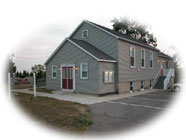A Brief History of Valley
Township
Townships were created and defined by the passage of the Land Ordinance of 1785, which laid out a grid work of townships, six miles long by six miles wide, across the frontier that surrounded the Great Lakes, along with the Northwest Ordinance of 1787 which defined the future organization of lands to the north and west of the original 13 states.
Valley Township is one of 1242 Townships in Michigan and is located in the southwest-central section of Allegan County in southwest Michigan. The township officials represent the level of government closest and most aware of resident’s wishes.
The duties that the Township is required to perform are assessment administration, elections administration, and tax collection. The Township also has broad powers to enact and enforce ordinances.
State laws authorize other functions of our township for our residents such as planning and zoning, fire protection, cemeteries, and the authority to enter into agreements with other governmental agencies or contract with the private sector to provide township services. The township also has some authority to control utility franchises and can provide special assessments for private road maintenance and street lights.
Surveyed in 1831, Valley Township was organized
as Pine Plains Township in 1850. This included
Clyde and Lee Townships, which would later
be separated from Pine Plains in 1859. The
area northwest of the river was taken from
Heath and given to Pine Plains in 1871.
This gave it its current borders. The first
settlers arrived circa 1837. The road from
Allegan to Saugatuck was surveyed circa
1834. This road intersects the township.
A post office was installed at Mill Grove
but it would later be shut down. On January
1, 1898, Pine Plains became Valley Township.
The reasoning was that the name Pine Plains
suggested sandy soil and would create little
demand for the sale of farm land.
Two hundred and fifty years ago the first
residents of what is now Valley Township
were the Ottawa and Pottawatomi Indians.
During that same period of time, wolves
and bears roamed the area. The first “white”
man to settle in this area was a man by
the name of Bushon. He opened a trading
post on the shore of the Kalamazoo River
where Lake Allegan is now. As a result of
this trading post, settlers came to this
area via boats, horses and later by train.
The Pere Marquette Railroad went through Valley Township and there was a train station in Millgrove. There was a second railroad (a narrow gauge) that ran from Allegan to Mill Pond at Swan Creek. It serviced the lumber industry that helped rebuild Chicago after the “Great Fire” of 1871. A high percentage of the lumber that was used to rebuild Chicago came from the Allegan area. The Allegan Dam backed up the Kalamazoo River and eventually formed the current 1,600 acre Lake Allegan. The dam was originally built to produce electricity for this area. Construction of the dam began in 1928, but it did not start to produce electricity until 1935. This dam is still in use today.
Lake Allegan has become a major recreational
area and a very desirable lake to build
and remodel homes on. It has helped Valley
Township to grow at a controlled rate. On
the West shoreline of Lake Allegan, there
are still foundations of buildings that
once made up a P.O.W. camp that housed German
prisoners during World War II. This camp
was in use until the end of the war. It
is interesting to note that the prisoners
thought the camp was located on Lake Michigan
and that they could escape by swimming to
Chicago.
From Appendix A, Valley
Township Master Plan 2009

Statistics
Valley Township has a total area of 93.2km2
or 36mi2. 85.3km2 (23.5mi2) of it is land
and 7.9km2 (3 mi2) is water. The total area
is 8.45% water. As of the 2010 census,
Valley Township had a population of 2,018
with 767 Households